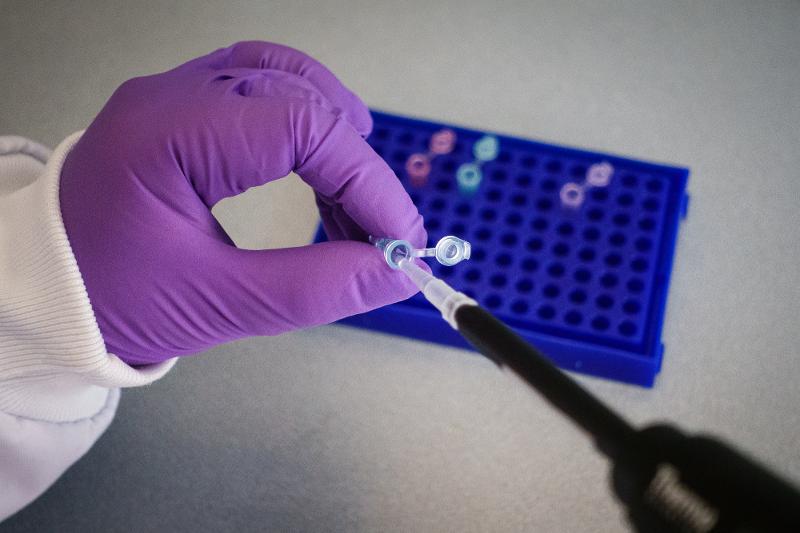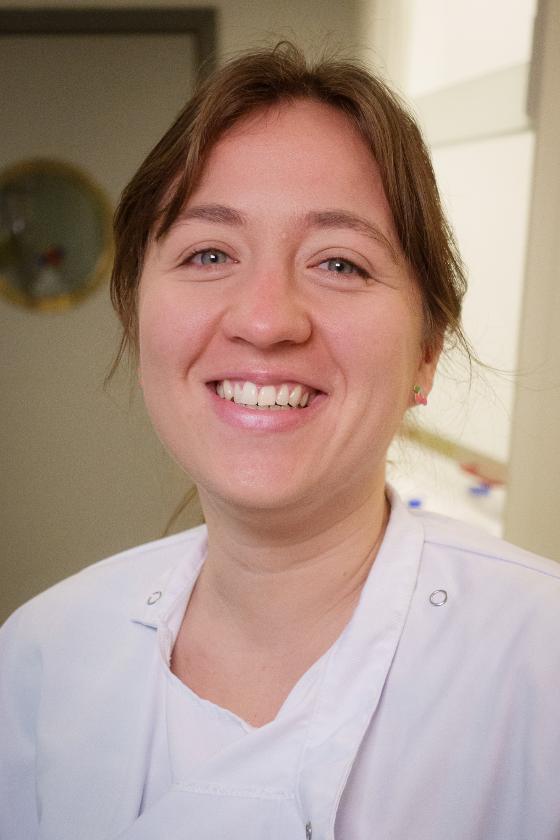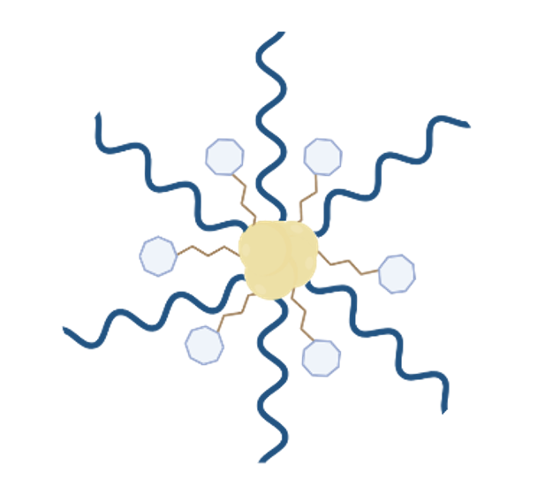The incredible power of DNA
We all know about DNA. It lives inside every cell in our bodies and shapes who we are and how we look. But what if we could use it as a tool against bacteria?

As we know, the resistance that bacteria have against our antibiotics is growing at an alarming rate. To make it even worse, these microorganisms have the capacity to form biofilms, where bacteria band together in groups and produce a sticky substance that protects them from external threats like antibiotics.
Imagine them using biofilm much in the same way as when we build houses to protect us from the rain and cold.
To wipe out such bacterial infections, we have to find new tools to break into and destroy these biofilms. And now we have. Using a clever combination of DNA and nanotechnology we have found a way to conquer this “Chateau Bacteria”.
The castle walls
These biofilms can be formed on different surfaces, for example in medical instruments or in our own bodies, such as the skin. This biofilm formation is particularly alarming as these structures are highly tolerant to antibiotics, meaning that it is very hard to penetrate that protective wall and kill the bacteria inside.
The formation of a biofilm on the skin is particularly scary if the skin is damaged, for example if you have an open wound. In those cases, biofilms are very difficult to remove, and antibiotics penetrate the biofilm very poorly. This means that most bacteria living inside the biofilm will survive.
After painting this alarming picture, what are our options in the fight against the biofilm and the bacteria? What kind of siege weapons do we have in our arsenal? Until now, not that many.
Nanotechnology to the rescue
Nanotechnology involves making really, really, really small particles. They can be up to a million times smaller than an ant. Nanoparticles can be made from many different materials like polymers (molecules strung together), lipids (fat or oils) or non-organic materials like silver or gold.

These particles are incredibly versatile, and in modern medicine for example, they can be used in both diagnostics, imaging, and drug delivery – transporting medicine to the right spot in our body.
By changing the physical and chemical properties of nanoparticles, we can give them the ability to carry antibiotics that penetrate the walls of the biofilm house, and then release it inside the “castle walls”.
The new star of the drug delivery show

But recently, a new star joined the show: good old DNA.
This ancient material is a reliable ally because you can program it to be in whatever shape and size you like without obvious toxicity. It has already been explored for use in cancer therapy, but could this old friend of ours be used for something else too?
Many successful approaches by other researchers have shown that nanoparticles were effective in delivering antibiotics against biofilms. However, the problem with DNA is that it both dissolves in water and has a negative electric charge. This is a problem when you are trying to attack biofilms, so we thought: “is there a way to tweak some of these properties in order for the DNA-nanoparticles to penetrate the biofilm”?
To make it short: Yes, there is!
Cholesterol – the unexpected sidekick
We decided to modify a DNA sequence by attaching a cholesterol molecule to it. Since cholesterol does not dissolve in water, the fat molecules tend to group together the same way it happens when we add oil in a pan of boiling water to cook pasta. The drops of oil come together to create oil bubbles.

By combining DNA and cholesterol, we were able to create tiny particles called micelles. The cholesterol is inside the micelle, and the outer layer of the nanoparticle is made up of DNA.
Our next question was, could we use this for drug delivery? Yes again!
When we added Polymyxin B, a last resort antibiotic used against the bacteria Pseudomonas aeruginosa, to the cholesterol-DNA, the whole particle structure became more stable. This has not been reported before, and it gave us a better understanding of how to combine antibiotics with modified DNA structures.
The next action hero
This finding was interesting, but we wanted to take it to the next level and explore if it could penetrate into the biofilm. That doesn’t happen easily, but to our enthusiasm, these drug-loaded DNA-based micelles – the nanoparticles - penetrated deep into the biofilm structure in just two hours!
The story got even better by observing that the antibiotic kept its effectiveness, killing the bacteria inside the biofilm and doing so without damaging skin cells.
This could mean that we might have on our hands a new approach for therapy against biofilms in wounds. DNA is, after all, the foundation of life itself - but it is also very encouraging to know that we can now unlock its full potential as drug delivery for antibiofilm purposes.
We just might be on the verge of witnessing the rise of the next action hero in the battle against biofilms and antibiotic resistant bacteria.
Scientific reference
"Polymyxin B stabilized DNA micelles for sustained antibacterial and antibiofilm activity against P. aeruginosa"
https://pubs.rsc.org/en/content/articlelanding/2023/tb/d3tb00704a
-
Fiskeri- og havbruksvitenskap - bachelor
Varighet: 3 År -
Fiskeri- og havbruksvitenskap - master
Varighet: 2 År -
Akvamedisin - master
Varighet: 5 År -
Bioteknologi - bachelor
Varighet: 3 År -
Arkeologi - master
Varighet: 2 År -
Geosciences - master
Varighet: 2 År -
Biology - master
Varighet: 2 År -
Physics - master
Varighet: 2 År -
Mathematical Sciences - master
Varighet: 2 År -
Biomedicine - master
Varighet: 2 År -
Public Health - master
Varighet: 2 År -
Molecular Sciences - master
Varighet: 2 År -
Biologi - bachelor
Varighet: 3 År -
Medisin profesjonsstudium
Varighet: 6 År -
Nordisk - årsstudium
Varighet: 1 År -
Luftfartsfag - bachelor
Varighet: 3 År -
Bioingeniørfag - bachelor
Varighet: 3 År -
Informatikk, datamaskinsystemer - bachelor
Varighet: 3 År -
Informatikk, sivilingeniør - master
Varighet: 5 År -
Likestilling og kjønn - årsstudium
Varighet: 1 År -
Geovitenskap- bachelor
Varighet: 3 År -
Biomedisin - bachelor
Varighet: 3 År -
Kjemi - bachelor
Varighet: 3 År -
Psykologi - bachelor
Varighet: 3 År -
Matematikk - årsstudium
Varighet: 1 År -
Ergoterapi - bachelor
Varighet: 3 År -
Fysioterapi - bachelor
Varighet: 3 År -
Radiografi - bachelor
Varighet: 3 År -
Samfunnssikkerhet - master
Varighet: 2 År -
Farmasi - bachelor
Varighet: 3 År -
Farmasi - master
Varighet: 2 År -
Romfysikk, sivilingeniør - master
Varighet: 5 År -
Klima og miljøovervåkning, sivilingeniør - master
Varighet: 5 År -
Bærekraftig teknologi, ingeniør - bachelor
Varighet: 3 År -
Psykologi - årsstudium
Varighet: 1 År -
Odontologi - master
Varighet: 5 År -
Tannpleie - bachelor
Varighet: 3 År -
Anvendt fysikk og matematikk, sivilingeniør - master
Varighet: 5 År -
Sykepleie - master
Varighet: 2 År -
Barnevern - bachelor
Varighet: 3 År -
Sosialt arbeid - bachelor
Varighet: 3 År -
Idrettsvitenskap - master
Varighet: 2 År -
Sosialt arbeid - master
Varighet: 2 År -
Praktisk-pedagogisk utdanning for trinn 8-13 - årsstudium (deltid)
Varighet: 2 År -
Vernepleie - bachelor
Varighet: 3 År -
Internasjonal beredskap - bachelor (samlingsbasert)
Varighet: 3 År -
Barnevern - bachelor
Varighet: 3 År -
Vernepleie - bachelor (deltid, samlingsbasert)
Varighet: 4 År -
Ernæring - bachelor
Varighet: 3 År -
Videreutdanning i krisehåndtering og traumebehandling
Varighet: 1 År



